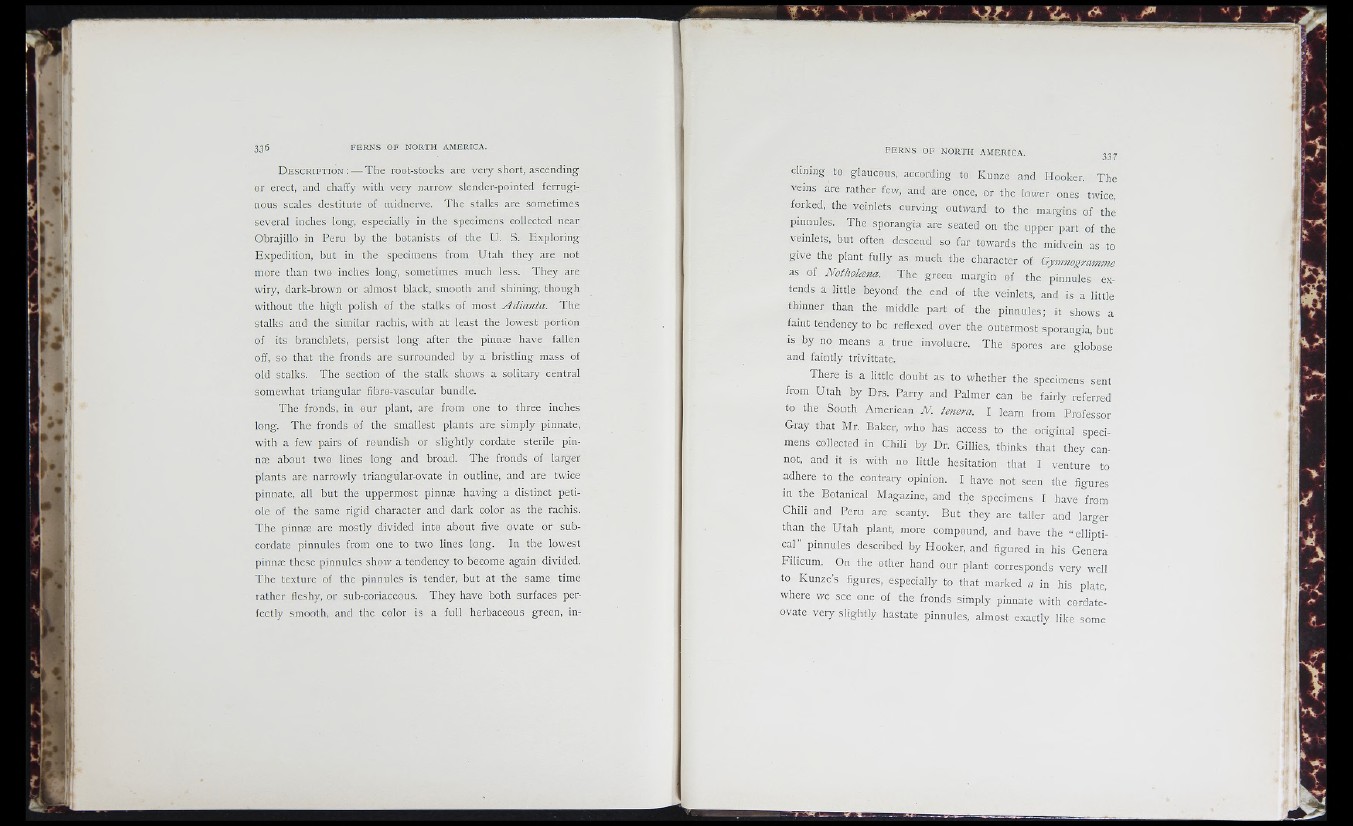
• I
' (
Ik*
. • >=r; .
" i :
> <'iî
S I '
I » « I
k
D e s c r i p t io n : — The root-stocks are very short, ascending
or erect, and chaffy with very narrow slender-pointed ferruginous
scales destitute of midnerve. The stalks are sometimes
several inches long, especially in the specimens collected near
Obrajillo in Peru by the botanists of the U. S. Exploring
Expedition, but in the specimens from Utah they are not
more than two inches long, sometimes much less. They are
wiry, dark-brown or almost black, smooth and shining, though
without the high polish of the stalks of most Adianta. The
stalks and the similar rachis, with at least the lowest portion
of its branchlets, persist long after the pinnæ have fallen
off, so that the fronds are surrounded by a bristling mass of
old stalks. The section of the stalk shows a solitary central
somewhat triangular fibro-vascular bundle.
The fronds, in our plant, are from one to three inches
long. The fronds of the smallest plants are simply pinnate,
with a few pairs of roundish or slightly cordate sterile pinnæ
about two lines long and broad. The fronds of larger
plants are narrowly triangular-ovate in outline, and are twice
pinnate, all but the uppermost pinnæ having a distinct petiole
of the same rigid character and dark color as the fachis.
The pinnæ are mostly divided into about five ovate or sub-
cordate pinnules from one to two lines long. In the lowest
pinnæ these pinnules show a tendency to become again divided.
The texture of the pinnules is tender, but at the same time
rather fleshy, or sub-coriaceous. They have both surfaces perfectly
smooth, and the color is a full herbaceous green, inclining
to glaucous, according to Kunze and Hooker. The
veins are rather few, and are once, or the lower ones twice,
forked, the veinlets curving outward to the margins of tlm
pinnules. The sporangia are seated on the upper part of the
veinlets, but often descend so far towards the midvein as to
give the plant fully as much the character of Gyvmogramme
as of Notholcena. The green margin of the pinnules extends
a little beyond the end of the veinlets, and is a little
thinner than the middle part of the pinnules; it shows a
faint tendency to be reflexed over the outermost sporangia, but
is by no means a true involucre. The spores are globose
and faintly trivittate.
There is a little doubt as to whether the specimens sent
from Utah by Drs. Parry and Palmer can be fairly referred
to the South American Ad tenera. I learn from Professor
Gray that Mr. Baker, who has access to the original specimens
collected in Chili by Dr. Gillies, thinks that they cannot,
and it is with no little hesitation that I venture to
adhere to the contrary opinion. I have not seen the figures
in the Botanical Magazine, and the specimens I have from
Chili and Peru are scanty. But they are taller and larger
than the Utah plant, more compound, and have the "ellipti-
cal" pinnules described by Hooker, and figured in his Genera
Filicum. On the other hand our plant corresponds very well
to Kunze's figures, especially to that marked « in his plate,
where we see one of the fronds simply pinnate with cordate-
ovate very slightly hastate pinnules, almost exactly like some